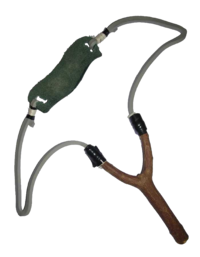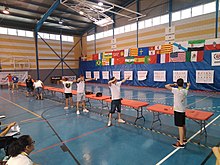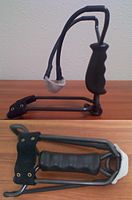Slingshot

Aslingshotorcatapultis a small hand-powered projectileweapon.The classic form consists of a Y-shaped frame, with twonatural rubberstrips or tubes attached to the upper two ends. The other ends of the strips lead back to a pouch that holds theprojectile.One hand holds the frame, while the other hand grasps the pocket and draws it back to the desired extent to provide power for the projectile—up to a full span of the arms with sufficiently long bands.
Other names includecatapult(United Kingdom),peashooter(United States),gulel(India),kettie(South Africa), orging,shanghai,pachoonga(Australia and New Zealand)
Use and history[edit]
Slingshots depend on strongelasticmaterials for theirprojectilefirepower, typicallyvulcanizednatural rubberor the equivalent such as silicone rubber tubing, and thus date no earlier than the invention of vulcanized rubber byCharles Goodyearin 1839 (patented in 1844). By 1860, this "new engine" had established a reputation for use by juveniles in vandalism. For much of their early history, slingshots were a "do-it-yourself" item, typically made from a forked branch to form the Y-shaped handle, with rubber strips sliced from items such asinner tubesor other sources of good vulcanized rubber, and loosing suitably sized stones.[citation needed]
While early slingshots were most associated with young vandals, they could be effective hunting arms in the hands of a skilled user. Firing projectiles, such as leadmusketballs,buckshot,steelball bearings,air gun pellets,or smallnails,a slingshot was capable of taking game such as quail, pheasant, rabbit, dove, and squirrel. Placing multiple balls in the pouch produces ashotguneffect (even though not very accurate), such as firing a dozenBBsat a time for hunting small birds. With the addition of a suitable rest, the slingshot can also be used to shootarrows,allowing the hunting of medium-sized game at short ranges.[1][2][3]
While commercially made slingshots date from at latest 1918, with the introduction of the Zip-Zip, a cast iron model,[4]it was not until the post–World War IIyears that slingshots saw a surge in popularity, and legitimacy. They were still primarily home-built; a 1946Popular Sciencearticle details a slingshot builder and hunter using home-built slingshots made from forkeddogwoodsticks to take small game at ranges of up to 9 m (30 ft) with No. 0 lead buckshot (8 mm [0.32 in] diameter).[5]
TheWham-Ocompany, founded in 1948, produced the Wham-O slingshot. It was made ofash woodand used flat rubber bands. The Wham-O was suitable for hunting, with a draw weight of up to 200newtons(45pounds-force), and was available with an arrow rest.[1][6]
The National Slingshot Association was founded in the 1940s, headquartered inSan Marino, California.It organised slingshot clubs and competitions nationwide. Despite the slingshot's reputation as a tool of juvenile delinquents, the NSA reported that 80% of slingshot sales were to men over 30 years old, many of them professionals. John Milligan, a part-time manufacturer of thealuminium-framed John Milligan Special, a hunting slingshot, reported that about a third of his customers were physicians.[6]
The middle 1950s saw two major innovations in slingshot manufacture, typified by the Wrist-Rocket which was produced by the Saunders Archery Co. ofColumbus, Nebraska.The Wrist-Rocket was made from bent aluminum alloy rods that formed not only the handle and fork, but also a brace that extended backwards over the wrist, and provided support on the forearm to counter thetorqueof the bands. The Wrist-Rocket also used surgical rubber tubing rather than flat bands, attached to the backwards-facing fork ends by sliding the tubing ends over the tips of the forks, where it was held by friction or adhered with the addition of liquidrosin.[citation needed]
The early production of the Wrist-Rocket slingshot was a joint effort between Saunders Archery Co., who came up with the trademark and developed the automated forming machinery, and Mark Ellenburg who came up with the basic design. A few years later Mark Ellenburg split away forming his own company called Tru-mark Manufacturing Company. Today Saunders Archery is still a major innovator in the slingshot industry with its line of flatband slingshots which use locking clips for band attachment and tuning.
Slingshots are also occasionally used inanglingto disperse bait over an area of water, so that fish may be attracted.
A home-made derivative of a slingshot also exists, consisting of a rubberballooncut in half and tied to a tubular object such as the neck of a plastic bottle, or a small pipe. The projectile is inserted through the tube and into the cut balloon, and the user stretches the balloon to launch the projectile. These so-called "balloon guns" are sometimes made as a substitute to ordinary slingshot, and are often used to create the "shotgun" effect with several projectiles fired at once.
In modern times the slingshot has been used by civilians against governments. Examples of this are Hong Kong during the2019-2020 protestswhere they were used against theHong Kong Police Force,[7][8]by the Palestiniansagainst Israeli forces.[9][10]and by the Ukrainians during theMaidan Revolutionin 2014.[11][12]
-
A 1922 diagram showing the construction of an arrow-firing slingshot
-
A folding, steel framed wrist brace slingshot using tubular bands. Marketed by the Riley Kitchen Air Rifle Company.
-
Modern slingshot withergonomicgrip (center), arm support (left), stabiliser and sight (right)
-
Helmeted combatant fires a slingshot duringclashes on February 18, 2014,in Kyiv, Ukraine
Military use[edit]
Slingshots have been used as military weapons, but primarily by guerrilla forces due to the easily available resources and technology required to construct one. Such guerrilla groups included theIrish Republican Army;[citation needed]prior to the2003 invasion of Iraq,Saddam Husseinreleased apropagandavideo demonstrating slingshots as a possibleinsurgency weaponfor use against invading forces.[13]
Slingshots have also been used by the military to launchunmanned aerial vehicles(UAVs). Two crew members form the fork, with an elastic cord stretched between them to provide power to launch the small aircraft.[14]
On theBattle of Marawi,the soldiers of the Philippine Army's eliteScout Rangerswere observed using slingshots with grenades as an improvised mortar to attackMauteandAbu Sayyafforces.[15]
Sport[edit]
This sectionneeds expansion.You can help byadding to it.(June 2022) |

There arecompetitions,quite popular inSpain,ItalyandChina.[16]
Dangers[edit]
One of the dangers inherent in slingshots is the high probability that the bands will fail. Most bands are made fromlatex,which degrades with time and use, causing the bands to eventually fail under load.[3][17]Failures at the pouch end are safest, as they result in the band rebounding away from the user. Failures at the fork end, however, send the band back towards the shooter's face, which can cause eye and facial injuries.[18]One method to minimize the chance of a fork end failure is to utilize a tapered band, thinner at the pouch end, and thicker and stronger at the fork end.[19]Designs that use loose parts at the fork are the most dangerous, as they can result in those parts being propelled back towards the shooter's face, such as the ball attachment used in the recalled Daisy "Natural" line of slingshots (see image). The band could slip out of the slot in which it rested, and the hard ball in the tube resulted in cases of blindness and broken teeth. Daisy models using plain tubular bands were not covered in the recall, because the elastic tubing does not cause severe injuries upon failure.[18]Another big danger is the fork breakage; some commercial slingshots made from cheap zinc alloy may break and severely injure shooters' eyes and face.[20]
-
A tubular band slingshot showing a band failure at the fork.
-
The ball-in-band attachment method used by the recalled Daisy "Natural" line of slingshots.
Legal issues[edit]
Many jurisdictions prohibit the use of arm-braced slingshots. For example,New YorkPenal law 265.01 defines it as a Class-4 misdemeanor,[21]andAustraliaalso considers them a prohibited weapon.[22]
See also[edit]
- Bow and arrow
- Crossbow
- Dart gun
- Bullet-shooting crossbow
- Harpoon
- Polespear
- Hawaiian sling
- Sling
- Catapult
- Trebuchet
- Projectile
- Timorese hook dart
References[edit]
- ^abWham-O Hunting Slingshot.Wham-O Manufacturing Co. 1963.
- ^"How to Make a Slingshot for an Arrow".Illustrated World.37(1). R. T. Miller Jr.: 318 March 1922.
- ^abMelchior Menzel."Rubber Bands".
- ^Melchior Menzel."The ZipZip".
- ^Tom Cushing (August 1946)."Rubber-Band Sharpshooter".Popular Science:154–155.
- ^abRobert Hertzberg (April 1951)."Return of the Giant Killer".Mechanix Illustrated.Archived fromthe originalon 2012-03-09.Retrieved2011-04-22.
- ^"Hong Kong protesters wielding bows and arrows hunker down at universities".ABC.13 November 2019.
- ^Kuo, Lily (4 August 2019)."Hong Kong protesters use flashmob tactics to evade police".The Guardian.
- ^Palestinian Music and Song Expression and Resistance Since 1900.Indiana University Press.2013. p. 133.
- ^Sirhan, Nadia R. (2012).Reporting Palestine-Israel in British Newspapers An Analysis of British Newspapers.Springer International Publishing.p. 73.
- ^"Enraged protesters storm Ukraine government offices".CBS News.23 January 2014.
- ^Lawson, George (2019).Anatomies of Revolution.Cambridge University Press.p. 182.
- ^Shane, Scott (2006-11-24)."In Video, Hussein Uses Slingshots and Bows to Rally Iraqis for War".The New York Times.Retrieved2009-12-21.
- ^Tech. Sgt. Paul Dean (February 1, 2021)."Security Forces Unmanned Aerial Vehicles".Air Force News Service. Archived fromthe originalon 2012-03-29.
- ^"LOOK: Scout Rangers use improvised giant slingshot in Marawi, Angry Birds style - Update Philippines".
- ^"18th Spanish national slingshot championship (in Spanish)".3 August 2019.
- ^Melchior Menzel."Attaching the bands to the frame".
- ^abU.S. Consumer Product Safety Commission."Slingshots Recalled by Daisy Manufacturing Due to Risk of Serious Eye Injury"(PDF).Archived fromthe original(PDF)on 2006-05-10.Retrieved2011-04-27.
- ^Melchior Menzel."Attaching the pouch to the bands".
- ^DANKUNG."Danger of zinc alloy slingshots".
- ^"SECTION 265.01: Criminal possession of a weapon in the fourth degree".The New York State Senate.
- ^"Prohibited Weapons | Australian Police".2012-09-01.Retrieved2023-03-19.
External links[edit]
 Media related toSlingshotsat Wikimedia Commons
Media related toSlingshotsat Wikimedia Commons






